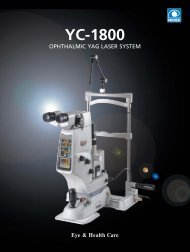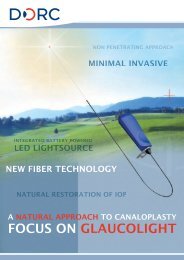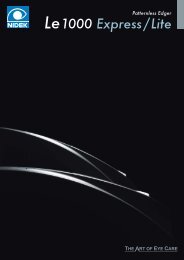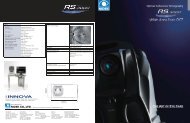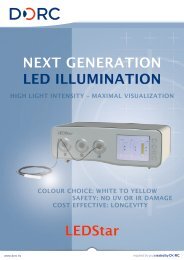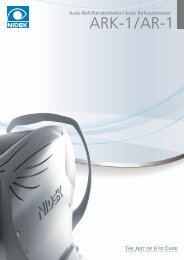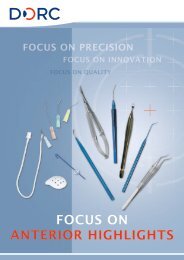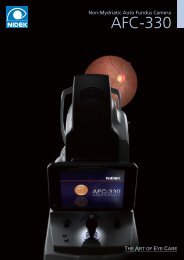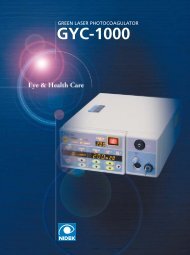Reichert Ocular Response Analyzer Measures Corneal ... - innova
Reichert Ocular Response Analyzer Measures Corneal ... - innova
Reichert Ocular Response Analyzer Measures Corneal ... - innova
- No tags were found...
You also want an ePaper? Increase the reach of your titles
YUMPU automatically turns print PDFs into web optimized ePapers that Google loves.
Figure 12 – <strong>Corneal</strong> hysteresis of 15 eyes pre- and post-LASIKIn addition to the possible uses already discussed, someexperts believe that the CH measurement will be usefulin customizing ablation algorithms in order to betterpredict and control LASIK outcomes. While this ispurely hypothetical at the present time, studies are beingpursued to explore this possibility.NeyesAvemmHgRangemmHgSt DevmmHgIOPGNormals 246 15.10 7.03 – 24.92 3.22POAG 289 15.97 4.01 – 55.00 5.26NTG 24 16.07 12.05 – 21.32 2.30CHNormals 246 11.19 7.24 - 15.80 1.63POAG 289 10.08 2.07 - 19.96 2.32NTG 24 8.82 6.80 – 11.59 1.39CRFNormals 246 10.46 5.37 - 15.74 1.75POAG 289 9.30 1.70 – 24.18 2.26NTG 24 8.67 6.35 – 12.60 1.50Table 3 – CH and CRF of normal, keratoconic, and Fuchs’ subjects<strong>Corneal</strong> Hysteresis and CRF in GlaucomaRecently, the <strong>Ocular</strong> Hypertension Treatment Study(OHTS), and other studies on the subject, have broughtto light the importance of Central <strong>Corneal</strong> Thickness(CCT) in diagnosing and managing glaucoma. Thesestudies have suggested that low CCT (thin cornea)may be an independent risk factor for the developmentand progression of the disease. Many experts believethat corneal parameters other than CCT may provideclues that will aid in the diagnosis and management ofglaucoma. Recent studies suggest that pathology in thelamina cribrosa may be reflected in detectable changes ofcorneal properties. Clinical studies utilizing the <strong>Ocular</strong><strong>Response</strong> <strong>Analyzer</strong> support this hypothesis.Compared to normals, glaucomatous subjects have asignificantly lower than average <strong>Corneal</strong> Hysteresis anda much wider range. A comparison of IOP, CH, and CRFvalues for normal, Primary Open Angled Glaucoma(POAG), and “Normal Tension Glaucoma” (NTG)populations is shown in Table 3. A histogram of CH forthe three populations is shown in Figure 13.An interesting observation is that lower-than-average CHis also observed in patients who have been identified asNTG subjects. Currently individuals who have NTG areoften missed during routine IOP screening. Obviouslyit would be a tremendous breakthrough if <strong>Corneal</strong>Hysteresis is proven to be a reliable indicator of thisdisease condition.Figure 13 – Comparing the corneal hysteresis distributionof normal and glaucomatous subjectsAlso noteworthy is the fact that signals obtained fromeyes of NTG subjects looks similar to the signalsobtained from keratoconus, Fuchs’, and post-LASIKpatients, reinforcing the theory that glaucomatousdamage, in some manner, presents itself via the cornea.The signal from a NTG subject’s eye is shown inFigure 14.Figure 14 – Signal obtained from the eye of an NTG subject



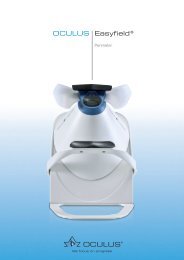
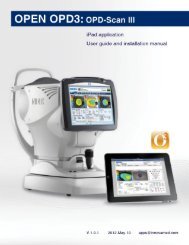
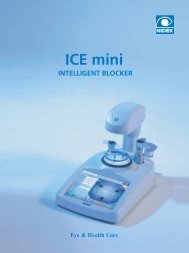
![OCT Setting: CORNEA RADIAL 6( 6.0mm[1024] ) - innova](https://img.yumpu.com/48127738/1/190x146/oct-setting-cornea-radial-6-60mm1024-innova.jpg?quality=85)
